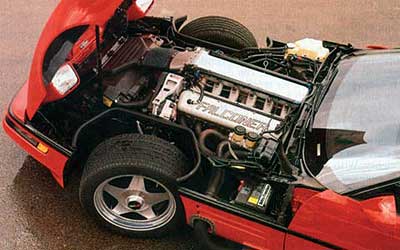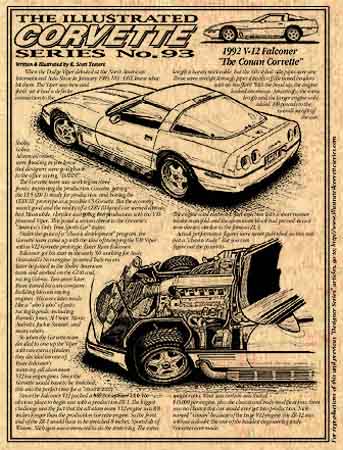Let’s Play, “Corvette Oddball!” Quirky Vette Factoids
Question: Did GM’s Chevrolet ever explore more than 8 cylinders for the Corvette?
By K. Scott Teeters, creator of Illustrated Corvette Series as seen in Vette Magazine
Answer: Briefly, but not deeply.
 The Dodge Viper certainly gets a lot of attention, thanks to its stunning good looks and impressive V-10 engine. Over the last few years we’ve seen high-end, luxury concept cars sporting V-10, V-12, and V-16 engines. But you know how it is with overcooked concept cars.
The Dodge Viper certainly gets a lot of attention, thanks to its stunning good looks and impressive V-10 engine. Over the last few years we’ve seen high-end, luxury concept cars sporting V-10, V-12, and V-16 engines. But you know how it is with overcooked concept cars.
Back in ’92 Corvette Engineering must have been in a press-teasing mood. They decided to show the car mags their latest engineering study that stretched a late-model Corvette to accommodate the 55.5-inch long, 601-C.I.D. Falconer aircraft engine that cranked out a leisurely 660-horsepower and 782 ft./lb. of torque.
The Corvette Engineering guys nick-named the car, “Conan the Corvette.”
I guess they just wanted to see what they’d have to do to make it fit. Clearly they weren’t real serious, as the exhaust dumped directly out of the tube headers and into long, collector side-pipes. It must have sounded AWESOME!
Of course, if you fast forward to today, no one imagined a day when a production Vette would be supercharged and pumping out 638-horsepower from just 376 cubic-inches. Yes, we’ll be talking about the new ZR1 for a very long time.
Here’s the official Falconer V-12 page from BlueThunderAirRacing.com…
http://www.bluethunderairracing.com/about/rfiv-12.htm
I invite you to read more about about “Conan the Corvette” in my Illustrated Corvette Series No. 93 as it appeared in Vette magazine a few years back..
Here’s the story:
Illustrated Corvette Series No. 93 – 1992 Falconer V-12 Experimental Corvette
“The Conan Corvette” by K. Scott Teeters
 When the Dodge Viper debuted at the North American International Auto Show in January 1989, NO ONE knew what hit them. The Viper was new and fresh, yet it had a definite connection to the Shelby Cobra. As advanced orders were flooding in you know that designers were going back to the office saying, “DAMN!”
When the Dodge Viper debuted at the North American International Auto Show in January 1989, NO ONE knew what hit them. The Viper was new and fresh, yet it had a definite connection to the Shelby Cobra. As advanced orders were flooding in you know that designers were going back to the office saying, “DAMN!”
The Corvette team was working on three fronts: improving the production Corvette, getting the LT-5 (ZR-1) ready for production, and honing the CERV III prototype as a possible C5 Corvette. But the economy wasn’t good and the reality of a CERV III-based car seemed dim at best Meanwhile, Chrysler was going into production with the V10-powered Viper. This posed a serious threat to the Corvette’s “America’s Only True Sports Car” status.
Under the guise of a “chassis development” program, the Corvette team came up with the idea of trumping the V10 Viper with a V12 Corvette prototype. Enter Ryan Falconer.
Falconer got his start in the early ’60s working for Andy Granatelli’s Novi engine -powered Indy racers. Later he joined in the Shelby American team and worked on the GT40 and racing Cobras. Two years later, Ryan started his own company, building his own racing engines. His associates reads like a “who’s who” of auto racing legends, including; Parnelli Jones, Al Unser, Mario Andretti, Jackie Stewart, and many others.
So when the Corvette team decided to one-up the Viper with two extra cylinders, they decided to go with one of Ryan Falconer’s stunning, all aluminum V12 racing engines. Since the Corvette would have to be stretched, this was the perfect time for a “chassis study.”
Since the Falconer V12 packed a 680-horsepower kick, the obvious place to begin was with a production ZR-1. The biggest challenge was the fact that the all-aluminum V12 engine was 8.8-inches longer than the production Corvette engine. So the front end of the ZR-1 would have to be stretched 8-inches. SportsFab of Wixom, Michigan was contracted to do the stretching. The extra length is barely noticeable, but the ’60s-styled side pipes sure are. Those were straight-through pipes directly off the tuned headers with no mufflers! With the hood up, the engine looked enormous. Amazingly, the extra length and the larger engine only added 100-pounds to the overall weight of the car. The engine used electronic fuel injection with a short-runner intake manifold and the aluminum block had pressed in cast iron sleeves, similar to the famous ZL-1
Actual performance figures were never published, as this was just a “chassis study.” But you can figure out the power-to-weight ratio. What was certain was that at $45,000 per engine, plus the chassis and body modifications, there was no chance this car would ever get into production. Nick-named “Conan” because of the huge V12 engine, the ZR-12 was without a doubt, the one of the baddest engineering study Corvettes ever made. – KST
For more Illustrated Corvette Series Artwork by K. Scott Teeters go to http://www.illustratedCorvetteSeries.com
Got a “Corvette Oddball” factoid that you’d like to share? Zip me off an e-mail at, lightoak@comcast.net and I’ll include it in the next post here at www.CorvetteReport.com.
____________________________________________________________

_____________________________________________________________________________
Related Links:
Experimental Corvettes by K. Scott Teeters



I truly believe there is nothing so special in the world of horsepower as non-flying vehicles powered by aircraft engines. I guess it’s partly the inherent metaphor, and partly the romance hammered into me by the aural glory of old WWII warbird engines I heard at airshows as a kid, both radials and the mighty P-51’s Merlin V12. I was watching this History channel program last weekend about rumrunners, and they detailed these Prohibition-era rumrunning boats powered by WWI-vintage Liberty engines (two of them @ 550 hp each) — the tax agents’ vessels were no match for those, hah.
I’d never heard of the Falconer concept until now. Great stuff, once again.
Seattle Car Guy, thanks for the nice comments. The Falconer Corvette got very little press attention. When the Dodge Viper came out in ‘89 it stole some of the ZR-1’s thunder. I’m sure that when the Corvette designers found out that the Viper had a V-10 engine, the “stuff” hit the fan. The V-12 Falconer Corvette was arguably one of the strangest Corvette engineering cars ever made. Those guys were having WAY too much fun! Also, it’s unfortunate that performance figures were never published. Perhaps the car was never completely sorted out. But with 680-horsepower and “God only knows” how much torque, it must have been a delightful handful!
Too bad there isn’t video on the Falconer Corvette. The last I read was that the car resides at The National Corvette Museum.
Considering the 638-horsepower C6 ZR1, the Falconer Corvette’s performance should have been at least on par with the ZR1 or a little better. A good part of the ZR1’s astonishing performance comes from it’s advanced tire and traction-control computer management system. Lingenfelter Performance Engineering is working on a package of bolt-on parts for the ZR1 that squeeze out even more HP from the LS9. I’ll be blogging about this car in a week or so, but for now, you can watch this mildly modified ZR1 run in the high 9s! No weight was taken out of the car and all the creature comforts are in tact. Here’s the link…
http://www.youtube.com/watch?v=F4ndvQ4GEww
I LOVE the nasty “GRRRRR” sound in between shifts.
And while on the topic of unusual power plants for Corvettes, we’ll be posting a story on the Granatelli Turbine Corvette in a few days. MORE fun stuff coming up soon! – K. Scott Teeters